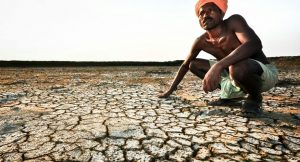
Source: United Nations University
Preface. By 2050 95% of Earth’s land could be degraded and reducing or even preventing food production, forcing hundreds of millions to migrate.
More than 75% of our planet has been altered by humans, a figure that will likely rise to more than 90% by 2050, according to the first comprehensive assessment of land degradation and its impacts. The report, released this week by the Intergovernmental Science-Policy Platform on Biodiversity and Ecosystem Services, was prepared by more than 100 experts from around the world. Crops and livestock affect the greatest area—a third of all land—by contributing to soil erosion and water pollution. Wetlands are among the most impacted of ecosystems; 87% have been destroyed over the past 3 centuries (Science 2018). An even longer and more detailed report than that in the National Geographic below is here.
Alice Friedemann www.energyskeptic.com Author of Life After Fossil Fuels: A Reality Check on Alternative Energy; When Trucks Stop Running: Energy and the Future of Transportation”, Barriers to Making Algal Biofuels, & “Crunch! Whole Grain Artisan Chips and Crackers”. Women in ecology Podcasts: WGBH, Jore, Planet: Critical, Crazy Town, Collapse Chronicles, Derrick Jensen, Practical Prepping, Kunstler 253 &278, Peak Prosperity, Index of best energyskeptic posts
***
Leahy S (2018) 75% of Earth’s Land Areas Are Degraded. A new report warns that environmental damage threatens the well-being of 3.2 billion people. National Geographic.
MEDELLIN, COLOMBIA More than 75% of Earth’s land areas are substantially degraded, undermining the well-being of 3.2 billion people, according to the world’s first comprehensive, evidence-based assessment. These lands that have either become deserts, are polluted, or have been deforested and converted to agricultural production and are also the main causes of species extinctions.
If this trend continues, 95% of the Earth’s land areas could become degraded by 2050. That would potentially force hundreds of millions of people to migrate, as food production collapses in many places, the report warns. (Learn more about biodiversity under threat.)
“Land degradation, biodiversity loss, and climate change are three different faces of the same central challenge: the increasingly dangerous impact of our choices on the health of our natural environment,” said Sir Robert Watson, chair of the Intergovernmental Science-Policy Platform on Biodiversity and Ecosystem Services (IPBES), which produced the report (launched Monday in Medellin, Colombia).
IPBES is the “IPCC for biodiversity”—a scientific assessment of the status of non-human life that makes up the Earth’s life-support system. The land degradation assessment took three years and more than 100 leading experts from 45 countries.
Rapid expansion and unsustainable management of croplands and grazing lands is the main driver of land degradation, causing significant loss of biodiversity and impacting food security, water purification, the provision of energy, and other contributions of nature essential to people. This has reached “critical levels” in many parts of the world, Watson said in an interview.
Underlying Causes
Wetlands have been hit hardest, with 87% lost globally in the last 300 years. Some 54% have been lost since 1900. Wetlands continue to be destroyed in Southeast Asia and the Congo region of Africa, mainly to plant oil palm.
Underlying drivers of land degradation, says the report, are the high-consumption lifestyles in the most developed economies, combined with rising consumption in developing and emerging economies. High and rising per capita consumption, amplified by continued population growth in many parts of the world, are driving unsustainable levels of agricultural expansion, natural resource and mineral extraction, and urbanization.
Land degradation is rarely considered an urgent issue by most governments. Ending land degradation and restoring degraded land would get humanity one third of the way to keeping global warming below 2°C, the target climate scientists say we need to avoid the most devastating impacts. Deforestation alone accounts for 10 percent of all human-induced emissions.
Reference
News at a Glance. 2018. Alarm over land degradation. Science 359: 1444.
